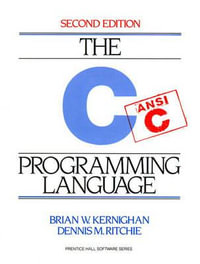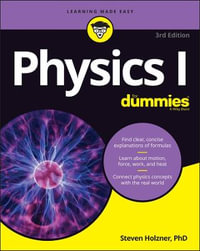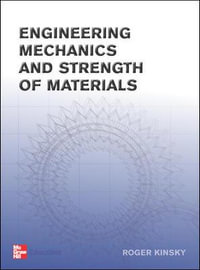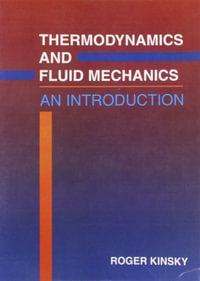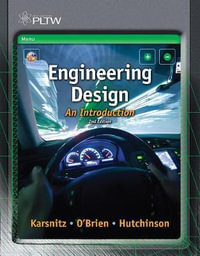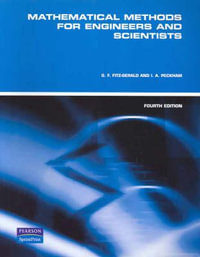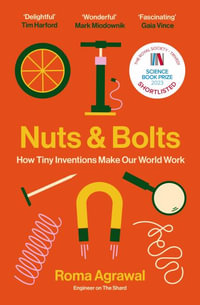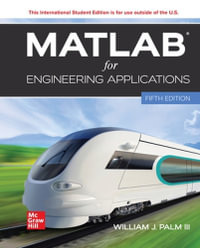
At a Glance
376 Pages
23.39 x 15.6 x 2.24
Hardcover
$264.27
or 4 interest-free payments of $66.07 with
orAims to ship in 7 to 10 business days
Machining is one of the most important manufacturing processes. Parts manufactured by other processes often require further operations before the product is ready for application. "Machining: Fundamentals and Recent Advances" is divided into two parts. Part I explains the fundamentals of machining, with special emphasis on three important aspects: mechanics of machining, tools, and work-piece integrity. Part II is dedicated to recent advances in machining, including: machining of hard materials, machining of metal matrix composites, drilling polymeric matrix composites, ecological machining (minimal quantity of lubrication), high-speed machining (sculptured surfaces), grinding technology and new grinding wheels, micro- and nano-machining, non-traditional machining processes, and intelligent machining (computational methods and optimization). Advanced students, researchers and professionals interested or involved in modern manufacturing engineering will find the book a useful reference.
Industry Reviews
Supplementary processes for material removal... such as electric discharge machining, electrochemical machining, ultrasonic machining, laser beam machining, and nanomachining have been in service for several decades. However, despite the extensive use of these processes, several questions remain unanswered. This book represents a fresh attempt to provide the long-overdue answers to some of these research questions. Its 12 chapters present the contributions of 24 of the best-qualified minds of eight countries. The first three chapters cover the basics of machining, with the remainder of the book focusing on newer techniques. Anyone with a research interest in the field of material removal will find this a valuable resource and a worthy addition to their professional and personal libraries... Recommended.
Choice (July 2009) (Reviewer: K. Srinagesh, University of Massachusetts Dartmouth)
| Metal Cutting Mechanics, Finite Element Modelling | p. 1 |
| Advanced Metal Cutting Mechanics | p. 1 |
| Objective of Metal Cutting Mechanics | p. 1 |
| State of the Art | p. 1 |
| Advanced Methodology | p. 4 |
| Combined Influence of the Minor Cutting Edge | p. 7 |
| Influence of the Cutting Speed, Depth of Cut and Cutting Feed on Power Partition | p. 9 |
| Concluding Remarks | p. 11 |
| Finite Element Analysis (FEA) | p. 13 |
| Numerical Formulations | p. 14 |
| Modelling Chip Separation from the Workpiece and Chip Segmentation | p. 15 |
| Mesh Design | p. 16 |
| Work Material Modelling | p. 18 |
| Modelling of Contact Conditions | p. 19 |
| Numerical Integration | p. 19 |
| Errors | p. 20 |
| Example | p. 20 |
| Advanced Numerical Modelling | p. 21 |
| Model Validation | p. 22 |
| References | p. 25 |
| Tools (Geometry and Material) and Tool Wear | p. 29 |
| Essentials of Tool Geometry | p. 29 |
| Importance of the Cutting Tool Geometry | p. 29 |
| Basic Terms and Definitions | p. 31 |
| System of Considerations | p. 32 |
| Basic Tool Geometry Components | p. 33 |
| Influence of the Tool Angles | p. 35 |
| Tool Materials | p. 37 |
| Carbides | p. 39 |
| Ceramics | p. 43 |
| Cubic Boron Nitride (CBN) | p. 44 |
| Polycrystalline Diamond (PCD) and Solid Film Diamond (SFD) | p. 45 |
| Tool Wear | p. 48 |
| Tool Wear Types | p. 48 |
| Tool Wear Evolution | p. 50 |
| Mechanisms of Tool Wear | p. 52 |
| Tool Life | p. 52 |
| Taylor's Tool Life Formula | p. 53 |
| Expanded Taylor's Tool Life Formula | p. 55 |
| Recent Trends in Tool Life Evaluation | p. 55 |
| References | p. 57 |
| Workpiece Surface Integrity | p. 59 |
| What Does Surface Integrity Mean? | p. 59 |
| Link Between Surface Integrity and its Manufacturing Procedure | p. 62 |
| Impact of the Surface Integrity on the Dimensional Accuracy | p. 64 |
| Impact of the Surface Integrity on Fatigue Resistance | p. 67 |
| Material and Mechanical Aspects of Surface Integrity | p. 68 |
| Mechanisms Leading to Material and Mechanical Modifications in Machining | p. 68 |
| Modelling of Residual Stresses | p. 74 |
| Experimental Approach | p. 80 |
| References | p. 91 |
| Machining of Hard Materials | p. 97 |
| Basic Features of HM | p. 97 |
| Definition of Hard Machining | p. 97 |
| Comparison with Grinding Operations | p. 98 |
| Technological Processes Including Hard Machining | p. 100 |
| Equipment and Tooling | p. 101 |
| Machine Tools | p. 101 |
| Cutting Tools and Materials | p. 102 |
| Complete Machining Using Hybrid Processes | p. 104 |
| Characterization of Hard Machining Processes | p. 105 |
| Cutting Forces | p. 105 |
| Chip Formation | p. 105 |
| Cutting Temperature | p. 108 |
| Wear of Ceramic and PCBN Tools | p. 110 |
| Modelling of Hard Cutting Processes | p. 110 |
| Surface Integrity in Hard Machining Processes | p. 113 |
| Surface Roughness | p. 113 |
| Residual Stresses | p. 114 |
| Micro/Nanohardness Distribution and White-Layer Effect | p. 115 |
| Modification of Surface Finish in Hybrid Processes | p. 117 |
| Cutting Errors and Dimensional Accuracy | p. 118 |
| Applications of Hard Machining Processes | p. 119 |
| Hard Turning | p. 119 |
| Hard and High-Speed Milling of Dies and Moulds | p. 120 |
| Hard Reaming | p. 121 |
| Hard Broaching | p. 122 |
| Hard Skive Hobbing | p. 122 |
| Optimization of Hard Machining Processes | p. 123 |
| References | p. 124 |
| Machining of Particulate-Reinforced Metal Matrix Composites | p. 127 |
| Introduction | p. 127 |
| Effect of Reinforcement Particles on Surface Integrity and Chip Formation | p. 129 |
| Strength of MMC During Machining | p. 130 |
| Chip Shape | p. 131 |
| Surface Integrity | p. 135 |
| Shear and Friction Angles | p. 142 |
| Relation Between Shear and Friction Angles | p. 144 |
| Forces | p. 145 |
| Modelling | p. 147 |
| Forces | p. 147 |
| Tool-Particle Interaction | p. 157 |
| Tool Wear | p. 159 |
| Performance of Cutting Tools | p. 159 |
| Modelling of Tool Wear | p. 161 |
| Acknowledgements | p. 162 |
| References | p. 162 |
| Drilling Polymeric Matrix Composites | p. 167 |
| Introduction | p. 167 |
| What Are Polymeric Matrix Composites? | p. 167 |
| The Importance of Drilling | p. 171 |
| Drilling Technology of Polymeric Matrix Composites | p. 173 |
| Conventional Drilling Process | p. 173 |
| Unconventional Drilling Processes | p. 178 |
| Modelling of Conventional Drilling | p. 179 |
| The Need for Modelling | p. 179 |
| Cutting Force Modelling | p. 180 |
| Damage Generated During Drilling and Residual Mechanical Properties | p. 183 |
| Structural Damage | p. 183 |
| Residual Mechanical Properties | p. 186 |
| Damage Suppression Methods | p. 188 |
| Introduction | p. 188 |
| Process Parameters Selection | p. 188 |
| Drilling Conditions | p. 189 |
| Special Tools | p. 190 |
| References | p. 191 |
| Ecological Machining: Near-dry Machining | p. 195 |
| Introduction | p. 195 |
| Amount and Cost | p. 196 |
| Health and Environmental Aspects | p. 197 |
| Principal Directions in the Reduction of MWF Economical, Ecological and Health Impacts | p. 198 |
| Nearly Dry Machining (NDM) | p. 201 |
| How NDM Operates | p. 201 |
| Classification of NDM | p. 202 |
| Why NDM Works | p. 212 |
| Consideration of the NDM System Components | p. 217 |
| References | p. 221 |
| Sculptured Surface Machining | p. 225 |
| Introduction | p. 225 |
| The Manufacturing Process | p. 227 |
| Technologies Involved | p. 228 |
| Five-axis Milling | p. 229 |
| The CAM, Centre of Complex Surfaces Production | p. 231 |
| Workpiece Precision | p. 233 |
| Cutting Forces | p. 235 |
| Workpiece Roughness | p. 237 |
| Tool Path Selection Using Cutting Force Prediction | p. 239 |
| Three-axis Case | p. 240 |
| Five-axis Case | p. 241 |
| Examples | p. 242 |
| Three-axis Mould | p. 242 |
| Five-axis Mould | p. 243 |
| Three-axis Deep Mould | p. 245 |
| Present and Future | p. 246 |
| Acknowledgements | p. 246 |
| References | p. 247 |
| Grinding Technology and New Grinding Wheels | p. 249 |
| Introduction | p. 249 |
| High-efficiency Grinding Using Conventional Abrasive Wheels | p. 250 |
| Introduction | p. 250 |
| Grinding Wheel Selection | p. 251 |
| Grinding Machine Requirements for High-efficiency Dressing | p. 253 |
| Diamond Dressing Wheels | p. 253 |
| Application of Diamond Dressing Wheels | p. 256 |
| Modifications to the Grinding Process | p. 257 |
| Selection of Grinding Process Parameters | p. 257 |
| Selection of Cooling Lubricant Type and Application | p. 258 |
| High-efficiency Grinding Using CBN Grinding Wheels | p. 258 |
| Introduction | p. 258 |
| Grinding Wheel Selection | p. 259 |
| Grinding Machine Requirements for High-efficiency CBN Grinding | p. 264 |
| Dressing High-efficiency CBN Grinding Wheels | p. 265 |
| Selection of Dressing Parameters for High-efficiency CBN Grinding | p. 266 |
| Selection of Cooling Lubrication for High-efficiency CBN Grinding Wheels | p. 266 |
| Internet Resources | p. 267 |
| References | p. 269 |
| Micro and Nanomachining | p. 271 |
| Introduction | p. 271 |
| Machining Effects at the Microscale | p. 272 |
| Shear Angle Prediction | p. 275 |
| Plastic Behaviour at Large Strains | p. 278 |
| Langford and Cohen's Model | p. 278 |
| Walker and Shaw's Model | p. 279 |
| Usui's Model | p. 280 |
| Saw-tooth Chip Formation in Hard Turning | p. 281 |
| Fluid-like Flow in Chip Formation | p. 281 |
| Size Effects in Micromachining | p. 282 |
| Nanomachining | p. 282 |
| Nanometric Machining | p. 283 |
| Theoretical Basis of Nanomachining | p. 284 |
| Comparison of Nanometric Machining and Conventional Machining | p. 294 |
| Acknowledgements | p. 295 |
| References | p. 295 |
| Advanced (Non-traditional) Machining Processes | p. 299 |
| Introduction | p. 299 |
| Mechanical Advanced Machining Processes (MAMP) | p. 301 |
| Ultrasonic Machining (USM) | p. 301 |
| Abrasive Water Jet Cutting (AWJC) | p. 304 |
| Thermoelectric Advanced Machining Processes | p. 307 |
| Electric Discharge Machining (EDM) and Wire EDM | p. 307 |
| Laser Beam Machining (LBM) | p. 312 |
| Electrochemical Advanced Machining Processes | p. 313 |
| Electrochemical Machining (ECM) | p. 313 |
| ECM Machine | p. 315 |
| Fine Finishing Processes | p. 317 |
| Abrasive Flow Machining (AFM) | p. 317 |
| Magnetic Abrasive Finishing (MAF) | p. 320 |
| Magnetic Float Polishing (MFP) | p. 323 |
| Micromachining | p. 324 |
| Finished Surface Characteristics | p. 325 |
| References | p. 325 |
| Intelligent Machining: Computational Methods and Optimization | p. 329 |
| Intelligent Machining | p. 329 |
| Neural Network Modelling | p. 332 |
| Fuzzy Set Theory | p. 339 |
| Neuro-fuzzy Modelling | p. 344 |
| A Note on FEM Modelling | p. 347 |
| Machining Optimization | p. 348 |
| Objective Functions and Constraints | p. 348 |
| Optimization Techniques | p. 350 |
| Future Challenges | p. 355 |
| References | p. 356 |
| Index | p. 359 |
| Table of Contents provided by Ingram. All Rights Reserved. |
ISBN: 9781848002128
ISBN-10: 1848002122
Published: 24th September 2008
Format: Hardcover
Language: English
Number of Pages: 376
Audience: College, Tertiary and University
Publisher: Springer Nature B.V.
Country of Publication: GB
Dimensions (cm): 23.39 x 15.6 x 2.24
Weight (kg): 0.75
Shipping
| Standard Shipping | Express Shipping | |
|---|---|---|
| Metro postcodes: | $9.99 | $14.95 |
| Regional postcodes: | $9.99 | $14.95 |
| Rural postcodes: | $9.99 | $14.95 |
How to return your order
At Booktopia, we offer hassle-free returns in accordance with our returns policy. If you wish to return an item, please get in touch with Booktopia Customer Care.
Additional postage charges may be applicable.
Defective items
If there is a problem with any of the items received for your order then the Booktopia Customer Care team is ready to assist you.
For more info please visit our Help Centre.
You Can Find This Book In
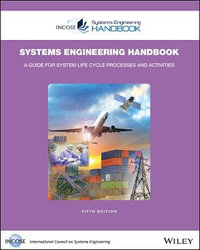
INCOSE Systems Engineering Handbook
5th Edition - A Guide for System Life Cycle Processes and Activities
Paperback
RRP $149.95
$92.50
OFF
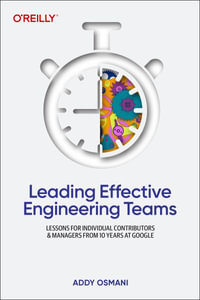
Leading Effective Engineering Teams
Lessons for Individual Contributors and Managers from 10 Years at Google
Paperback
RRP $76.00
$35.75
OFF
This product is categorised by
- Non-FictionEngineering & TechnologyTechnology in GeneralEngineering in General
- Non-FictionEngineering & TechnologyMechanical Engineering & MaterialsMaterials Science
- Non-FictionEngineering & TechnologyMechanical Engineering & MaterialsMechanical Engineering
- Non-FictionEngineering & TechnologyIndustrial Chemistry & Manufacturing TechnologiesMetals Technology & Metallurgy
- Non-FictionEngineering & TechnologyMechanical Engineering & MaterialsProduction & Industrial Engineering

